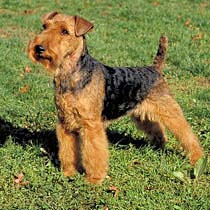|
The Canine Chronicles Directory
Welsh Terrier

Welsh Terriers are small, compact and rugged looking. They look very similar to
Airedale Terriers. They have wiry, rough coats that are usually black/tan, black,
tan or grizzle. Puppies are born black. The dogs with lighter coats will fade from
black as they mature. The long head should be flat and rectangular in shape. The
muzzle is squared at the end and the stop is undefined. They should have bushy eyebrows,
a mustache and a beard. The small, well-set eyes should be dark and almond-shaped.
The nose is black. The small, triangular-shaped ears sit fairly high on the head
and fold forward. The teeth meet in a level or scissor-like bite although scissor
is preferred when showing this breed. The slightly arched neck should be medium
in length and thickness and merge into sloping shoulders. The short body has a level
topline and the chest is well-ribbed. The muscular forelegs should be straight with
ample bone and the hindlegs should be strong with ample bone and muscular thighs.
The round feet are small and cat-like. The tail is generally docked. The front and
back leg dewclaws should be removed.
|
|
Temperament
|
Welsh Terriers are loving, curious, spunky, loyal, playful, energetic, and active
dogs. They are also very affectionate dogs and bond closely with their families.
However, they can sometimes be reserved with strangers. They are ideal with children
and can handle their rough and tumble games. This breed gets along with cats and
other small animals if introduced to them. If not, they will chase them. They enjoy
and prefer being the only dog in the household. They are not an aggressive breed
but they are brave and will be fearless if they have to. Some lines will be timid
if touched unexpectedly. To prevent this, the breed must be socialized when young.
They love to swim, dig and may be difficult to housebreak, especially a female.
|
|
Height, Weight
|
Height: No more than 15" ; Weight: 20-21 lbs.
|
|
Health Problems
|
This breed is prone to skin and eye problems.
|
|
Living Conditions
|
The Welsh Terrier will do okay living in an apartment. A small yard is sufficient.
|
|
Exercise
|
This breed is always ready for fun. They enjoy chasing balls and having the ability
to run off their lead in an open and safe area. They are not fussy about how much
they exercise.
|
|
Life Expectancy
|
About 10-12 years
|
|
Grooming
|
This breed needs to have their coat plucked several times a year. They also need
to be brushed several times a week. Show dogs require much more attention. Keep
the hair long at the feet, on the belly and around the face, giving him the appearance
of a typical terrier. This breed sheds little or no hair.
|
|
Origin
|
Welsh Terriers were developed in Carnarvonshire, Wales. In 1737 the residents prided
themselves on having pure bred Welsh Terriers. For over two and a half centuries
this breed was known by the name Carnarvonshire Welsh Terrier, due to its place
of origin. However, though it is not confirmed, this breed was actually thought
to be a descendant of the Old English Black and Tan (or the Broken-Coated Terrier).
The breed was used in packs for hunting otters, foxes, and badgers. The breed was
first shown in England in 1884 and was recognized as a separate breed in 1885. They
were imported to America in 1888; however, they were still grouped with the Old
English Terriers until 1901. They are recognized by the AKC and the UKC.
|
|
Group
|
AKC and UKC Terrier
|